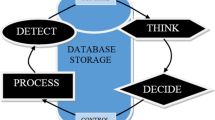Abstract
There are various techniques to safeguard computer systems and networks against illegal actions. Secure OS based on Role Based Access Control (RBAC) is one of the systems that reflect these techniques. The RBAC system controls access to system resources based on roles. Recently, many systems employ more fine-grained access control on system resources to enhance system security. However, this approach in access control level may cause unexpected problems, since most systems acquire system resources through system call that is hooked on kernel. In this paper, we propose a novel approach to Intrusion Detection System (IDS). The proposed Autonomic Protection System (APS) supports fine-grained intrusion detection. It resides above Secure OS based on RBAC that provides general-grained access control. The system detects intrusions using security policy based on RBAC model. The system performs double checking for intrusions using positive and negative intrusion detection policy. Additionally, as one of active responses, the system supports the self-adaptation of security policy depending on various computing environments. Therefore, the system can detect intrusions more accurately and respond to the attacks actively and appropriately.
This study was supported by the Brain Korea 21 Project in 2004.
Access this chapter
Tax calculation will be finalised at checkout
Purchases are for personal use only
Preview
Unable to display preview. Download preview PDF.
Similar content being viewed by others
References
Lin, A.: Integrating Policy-Driven Role Based Access Control with the Common Data Security Architecture. HP Labs Technical Reports, HPL-1999-59, 990430, External (1999)
Wright, C., Cowan, C., Morris, J., Smalley, S., Kroah-Hartman, G.: Linux Security Module Framework (2002), http://www.kroah.com/linux/talks/ols_2002_lsm_paper/lsm.pdf
Overview: Cisco Administrative Policy Engine, http://www.cisco.com/univercd/cc/td/doc/product/rtrmgmt/cape/admin_gd/ovrvw_ad.htm
Ferraiolo, D.F., Kuhn, D.R., Chandramouli, R.: Role-Based Access Control. Artech House, Inc., Norwood (2003)
Ghosh, A.K., Schwartzbard, A.: A study in using neural networks for anomaly and misuse detection. In: Proceeding of the 8th USENIX Security Symposium, Washington, D.C., USA, August 23-26 (1999)
Zhang, Z., Li, J., Manikopoulos, C.N., Jorgenson, J., Ucles, J.: HIDE: a Hierarchical Network Intrusion Detection System Using Statistical Preprocessing and Neural Network Classification. In: Proceedings of the 2001 IEEE Workshop on Information Assurance and Security United States Military Academy, West Point, NY (2001)
Chari, S.N., Cheng, P.-C.: BlueBox: A Policy-driven, Host-Based Intrusion Detection System. ACM Transactions on Information and System Security (TISSEC) 6(2), 173–200 (2003)
Ganek, A.G., Corbi, T.A.: The dawning of the autonomic computing era. Ibm Systems Journal, Vol 42(1) (2003)
Mainsah, E.: Autonomic computing: the next era of computing. Electronics & Communication Engineering Journal (2002)
Kephart, J.O., Chess, D.M.: The Vision of Autonomic Computing. The IEEE Computer Society, Los Alamitos (2003)
Autonomic Computing Overview Questions & Answers, http://www.research.ibm.com/autonomic/overview/faqs.html
Park, S.-h., Kim, W., Kim, D.-k.: Agent-Based Protection System in Autonomic Computing Environment. In: Proceedings of PRIMA 2003, pp. 117–128 (2003)
Stanger, J., Lane, P.T.: Hack Proofing Linux: A Guide to Open Source Security. Syngress Publishing Inc. (2001)
Foukia, N., Hassas, S., Hulaas, S.F.J.: An Intrusion Response An Intrusion Response Scheme: Tracking the Source Using the Stigmergy Paradigm. In: Proceedings of Security Of Mobile Multiagent Systems Ws, SEMAS 2002 (2002)
Carver Jr., C.A.: Intrusion Response Systems: A Survey. Department of Computer Science, Texas A&M University, College Station, TX 77843-3112, USA (2001)
Jansen, W., Mell, P., Karygiannis, T., Marks, D.: Mobile agents in intrusion detection and response. In: 12th Annual Canadian Information Technology Security Symposium, Ottowa, Canada (2000)
Author information
Authors and Affiliations
Editor information
Editors and Affiliations
Rights and permissions
Copyright information
© 2004 Springer-Verlag Berlin Heidelberg
About this paper
Cite this paper
Park, Sh., Kim, W., Kim, Dk. (2004). Autonomic Protection System Using Adaptive Security Policy. In: Laganá, A., Gavrilova, M.L., Kumar, V., Mun, Y., Tan, C.J.K., Gervasi, O. (eds) Computational Science and Its Applications – ICCSA 2004. ICCSA 2004. Lecture Notes in Computer Science, vol 3045. Springer, Berlin, Heidelberg. https://doi.org/10.1007/978-3-540-24767-8_94
Download citation
DOI: https://doi.org/10.1007/978-3-540-24767-8_94
Publisher Name: Springer, Berlin, Heidelberg
Print ISBN: 978-3-540-22057-2
Online ISBN: 978-3-540-24767-8
eBook Packages: Springer Book Archive




